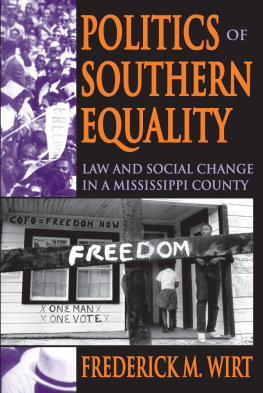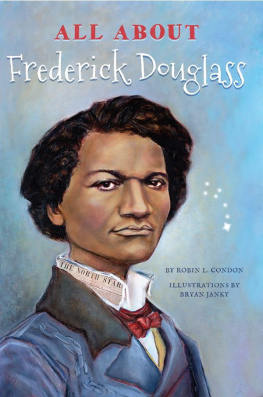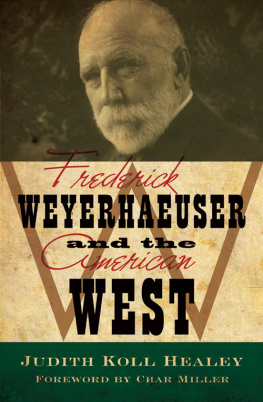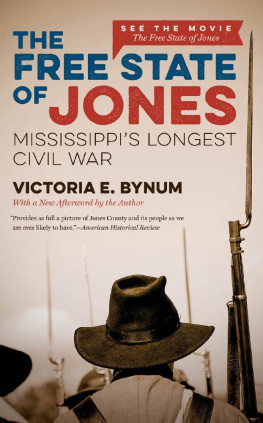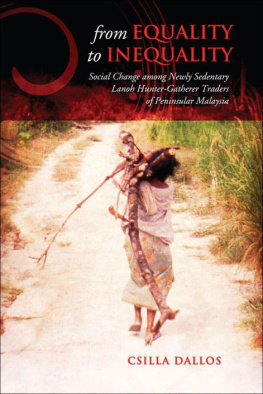
POLITICS OF SOUTHERN EQUALITY
POLITICS OF SOUTHERN EQUALITY
LAW AND SOCIAL CHANGE IN A MISSISSIPPI COUNTY
FREDERICK M. WIRT
First published 1970 by Transaction Publishers
Published 2017 by Routledge
2 Park Square, Milton Park, Abingdon, Oxon OX14 4RN
711 Third Avenue, New York, NY 10017, USA
Routledge is an imprint of the Taylor & Francis Group, an informa business
Copyright 1970 by Frederick M. Wirt.
All rights reserved. No part of this book may be reprinted or reproduced or utilised in any form or by any electronic, mechanical, or other means, now known or hereafter invented, including photocopying and recording, or in any information storage or retrieval system, without permission in writing from the publishers.
Notice:
Product or corporate names may be trademarks or registered trademarks, and are used only for identification and explanation without intent to infringe.
Library of Congress Catalog Number: 2008004463
Library of Congress Cataloging-in-Publication Data
Wirt, Frederick M.
Politics of Southern equality : law and social change in a Mississippi county / Frederick M. Wirt.
p. cm.
Originally published: Chicago : Aldine Pub. Co., [1971, c1970].
Includes bibliographical references and index.
ISBN 978-0-202-36190-1
1. Civil rightsMississippiPanola County. 2. Panola County (Miss.)Social conditions. 3. Panola County (Miss.)Politics and government. I. Title.
JC599.U52M638 2008
323.09762'84 2008004463
ISBN 13: 978-0-202-36190-1 (pbk)
To
BETTY
A woman of valour who can find? For her price is far above rubies.
* * * * * * * *
Her children rise up
and call her blessed;
Her husband also,
and he praiseth her:
Many daughters have done valiantly,
But thou excellest them all.
Proverbs 31.
Contents
Foreword
This book deals with the effects of recent federal civil rights legislation on the behavior and attitudes of the inhabitants of one single county in Mississippi Panola County. These effects are examined in the three civil rights areas of voting, education, and economic opportunities.
Panola County was chosen not because it is considered to be the most typical county in Mississippi, but rather because the change induced by federal laws and their enforcement seemed to have proceeded somewhat faster and farther there than in other counties and because these changes evolved with fewer incidents of violence.
The study also included comments on conditions and developments in the whole of Mississippi and, indeed, the entire South, particularly its nonmetropolitan areas.
The author's broader interest is to throw light on the use of legislation to effect social change, and the first chapter begins with a scrutiny of some of the theories about that relationship. The need to substitute empirical knowledge for such abstract speculation primarily motivates his study. Since we are beginning such empirical work, he has restricted his study to one county but with conclusions on future comparative studies.
The author sketches the historical setting of Panola County, laying stress on the demographic, economic, and political developments in recent decades. He then examines what has actually happened in the race relations field as an effect of the civil rights laws affecting votes, schools, and jobs. He utilizes whatever documentary material is available from federal, state, and county sources; local newspapers; and records from business and other groups. But his closer understanding came from personal interviews. He included those responsible for law enforcement and those who felt the impact of the new laws, in particular those who stood out as leaders among the whites and the Negroes.
Though he was careful not to disclose his own personal views and sought to register the beliefs and emotions of those interviewed, the value premises determining his viewpoint and therefore his questions were clearly the liberal views of what I once called the American Creed. He defines himself, with a quotation from John F. Kennedy, as an "idealist without illusions." He has understood that there is no view except from a viewpoint, no answers except to questions, and that the viewpoint and the questions contain valuations.
Because federal law is the dynamic factor setting the social system in movement, the author explains the interactions between public opinion, the President, and the Congress, which in the end resulted in the laws on votes, schools, and jobs. He also deals with the differing machinery of sanctions and enforcement. Concluding the study with chapters on the effect of law on social change, he attempts to draw from his empirical study a systematic, inclusive statement of the factors affecting compliance with such law.
I have read these and other more general portions of the book with interest and appreciation. But what has really excited me are the chapters in which he gives a detailed and systematic account of what actually happened in Panola County and draws inferences about why and how it happened. There the author not only makes his most original contribution to our knowledge but, indeed, produces a pioneering study. I would wish he and others would make similar studies in other counties in Mississippi, the whole South, and the whole country. Now that he has provided a tentative sketch of the general setting, it should be easier to go directly to the empirical study of the problems as they appear locally.
This is one type of study that is much too seldom undertaken. My feeling is that right on the other extreme on the axis of specification and generalization we have also had too few attempts to study the broad national problem of rational planning. To permit such planning, we must put the civil rights issue in the context of all the other conditions and developments in the United States. The Negro problem has to be placed in the setting of the larger poverty problem. The urban problem must be related to the rural slum problem that is in many ways primary. They are both related to the problem of transportation and to the tax system, not least the districting of the country for taxation purposes, and also the division of responsibilities for public expenditure among federal, state, and local political authorities.
Any such attempt to draw rational policy conclusions from data and established and perhaps alternative value premises needs, however, empirical knowledge of basic facts of the type the author has given us for Panola County.
Gunnar Myrdal
Stockholm University
Institute for International Economic Studies



